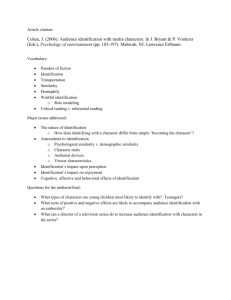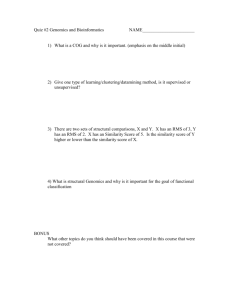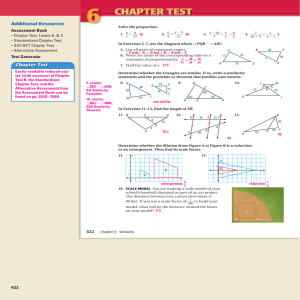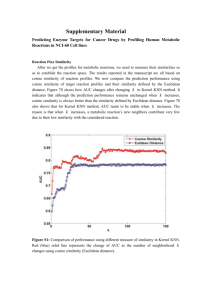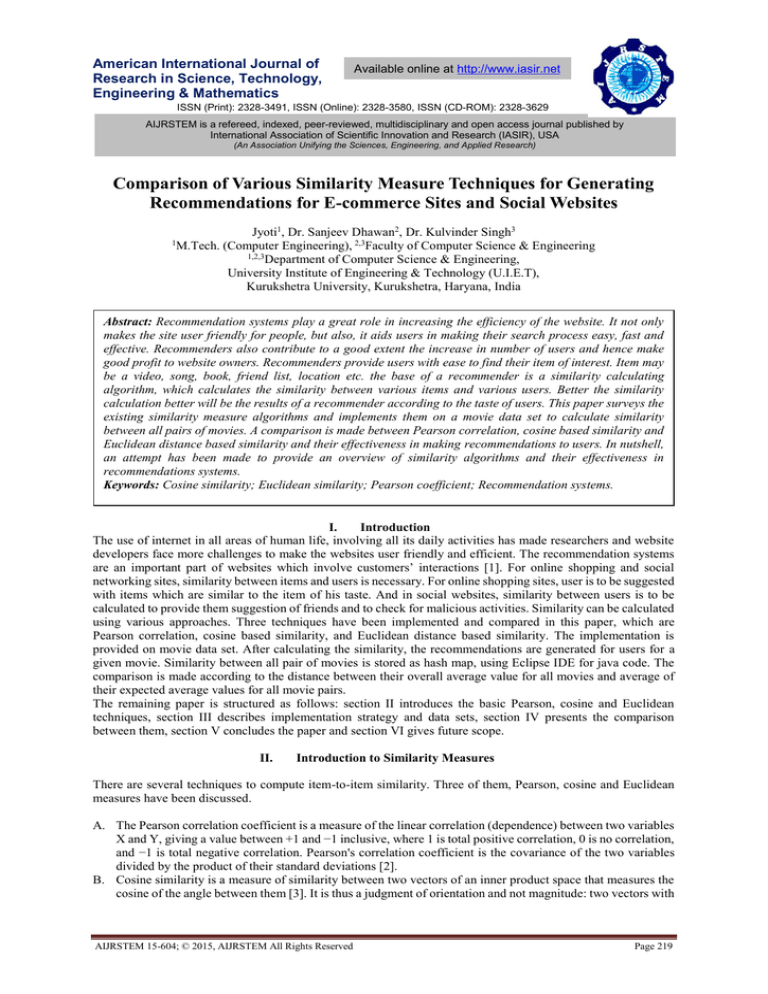
American International Journal of
Research in Science, Technology,
Engineering & Mathematics
Available online at http://www.iasir.net
ISSN (Print): 2328-3491, ISSN (Online): 2328-3580, ISSN (CD-ROM): 2328-3629
AIJRSTEM is a refereed, indexed, peer-reviewed, multidisciplinary and open access journal published by
International Association of Scientific Innovation and Research (IASIR), USA
(An Association Unifying the Sciences, Engineering, and Applied Research)
Comparison of Various Similarity Measure Techniques for Generating
Recommendations for E-commerce Sites and Social Websites
Jyoti1, Dr. Sanjeev Dhawan2, Dr. Kulvinder Singh3
M.Tech. (Computer Engineering), 2,3Faculty of Computer Science & Engineering
1,2,3
Department of Computer Science & Engineering,
University Institute of Engineering & Technology (U.I.E.T),
Kurukshetra University, Kurukshetra, Haryana, India
1
Abstract: Recommendation systems play a great role in increasing the efficiency of the website. It not only
makes the site user friendly for people, but also, it aids users in making their search process easy, fast and
effective. Recommenders also contribute to a good extent the increase in number of users and hence make
good profit to website owners. Recommenders provide users with ease to find their item of interest. Item may
be a video, song, book, friend list, location etc. the base of a recommender is a similarity calculating
algorithm, which calculates the similarity between various items and various users. Better the similarity
calculation better will be the results of a recommender according to the taste of users. This paper surveys the
existing similarity measure algorithms and implements them on a movie data set to calculate similarity
between all pairs of movies. A comparison is made between Pearson correlation, cosine based similarity and
Euclidean distance based similarity and their effectiveness in making recommendations to users. In nutshell,
an attempt has been made to provide an overview of similarity algorithms and their effectiveness in
recommendations systems.
Keywords: Cosine similarity; Euclidean similarity; Pearson coefficient; Recommendation systems.
I.
Introduction
The use of internet in all areas of human life, involving all its daily activities has made researchers and website
developers face more challenges to make the websites user friendly and efficient. The recommendation systems
are an important part of websites which involve customers’ interactions [1]. For online shopping and social
networking sites, similarity between items and users is necessary. For online shopping sites, user is to be suggested
with items which are similar to the item of his taste. And in social websites, similarity between users is to be
calculated to provide them suggestion of friends and to check for malicious activities. Similarity can be calculated
using various approaches. Three techniques have been implemented and compared in this paper, which are
Pearson correlation, cosine based similarity, and Euclidean distance based similarity. The implementation is
provided on movie data set. After calculating the similarity, the recommendations are generated for users for a
given movie. Similarity between all pair of movies is stored as hash map, using Eclipse IDE for java code. The
comparison is made according to the distance between their overall average value for all movies and average of
their expected average values for all movie pairs.
The remaining paper is structured as follows: section II introduces the basic Pearson, cosine and Euclidean
techniques, section III describes implementation strategy and data sets, section IV presents the comparison
between them, section V concludes the paper and section VI gives future scope.
II.
Introduction to Similarity Measures
There are several techniques to compute item-to-item similarity. Three of them, Pearson, cosine and Euclidean
measures have been discussed.
A. The Pearson correlation coefficient is a measure of the linear correlation (dependence) between two variables
X and Y, giving a value between +1 and −1 inclusive, where 1 is total positive correlation, 0 is no correlation,
and −1 is total negative correlation. Pearson's correlation coefficient is the covariance of the two variables
divided by the product of their standard deviations [2].
B. Cosine similarity is a measure of similarity between two vectors of an inner product space that measures the
cosine of the angle between them [3]. It is thus a judgment of orientation and not magnitude: two vectors with
AIJRSTEM 15-604; © 2015, AIJRSTEM All Rights Reserved
Page 219
Jyoti et al., American International Journal of Research in Science, Technology, Engineering & Mathematics, 11(2), June-August, 2015, pp.
219-221
the same orientation have a cosine similarity of 1, two vectors at 90° have a similarity of 0, and two vectors
diametrically opposed have a similarity of 1, independent of their magnitude.
C. The Euclidean distance or Euclidean metric is the "ordinary" (i.e. straight line) distance between two points
in Euclidean space [4]. The distance between two points on the real line is the absolute value of their
numerical difference.
II.
Implementation Strategy and Data Set
Having introduced the basic definitions of the similarity measures, it can now be deployed on the custommade search systems and recommendation engines.
A. Data set: The dataset used in this research is movie data which has three attributes namely, user-id, movieid, and user-ratings. These ratings are then defined into five class i.e. bad, ok, average, good, and excellent.
There are 100000 entries for user ratings. There are 943 users who provide different ratings to 1682 different
movies. A subset of this data set is used for computing similarity between movie pairs. The data set has been
obtained from MovieLens web site (http://movielens.org) which is collected and made available by
GroupLens research [5].
B. Implementation Approach:
First, create a hash-map of movie rating table for all pairs of movies.
Find users who have rated both of the two movies, for each pair.
Find average ratings for the two movies, for each pair.
Compute Pearson based similarity.
o
𝑠𝑖𝑚𝑖𝑙𝑎𝑟𝑖𝑡𝑦 =
∑𝑖[(𝑟𝑎𝑡𝑖𝑛𝑔1 [𝑖]−𝑎𝑣𝑒𝑟𝑎𝑔𝑒1) × (𝑟𝑎𝑡𝑖𝑛𝑔2 [𝑖]−𝑎𝑣𝑒𝑟𝑎𝑔𝑒2)]
√∑𝑖(𝑟𝑎𝑡𝑖𝑛𝑔1 [𝑖]−𝑎𝑣𝑒𝑟𝑎𝑔𝑒1)2 ×√∑𝑖(𝑟𝑎𝑡𝑖𝑛𝑔2 [𝑖]−𝑎𝑣𝑒𝑟𝑎𝑔𝑒2)2
Compute Euclidean distance based similarity.
o 𝑑𝑖𝑠𝑡𝑎𝑛𝑐𝑒 = √∑𝑖(𝑟𝑎𝑡𝑖𝑛𝑔1 [𝑖] − 𝑟𝑎𝑡𝑖𝑛𝑔2 [𝑖])2
o 𝑠𝑖𝑚𝑖𝑙𝑎𝑟𝑖𝑡𝑦 = 1⁄(1 + 𝑑𝑖𝑠𝑡𝑎𝑛𝑐𝑒)
Compute cosine based similarity.
∑𝑖[(𝑟𝑎𝑡𝑖𝑛𝑔1 [𝑖]) × (𝑟𝑎𝑡𝑖𝑛𝑔2 [𝑖])]
o 𝑠𝑖𝑚𝑖𝑙𝑎𝑟𝑖𝑡𝑦 = (𝑟𝑎𝑡𝑖𝑛𝑔1
[𝑖])2
(𝑟𝑎𝑡𝑖𝑛𝑔2 [𝑖])2
√∑𝑖
×√∑𝑖
III.
Results
Comparison based on computed values is given in table 1:
Table 1: comparison of expected and obtained
Total average value for 10000 movie pairs
Average RMSE value corresponding to Pearson
similarity
Average RMSE value corresponding to Cosine
similarity
Average RMSE value corresponding to Euclidean
distance based similarity
Average expected value
Average Pearson similarity value
Average Cosine similarity value
Average Euclidean similarity value
5223.309572
1.008200076
0.3991831217
0.4894081776
0.522330957
1.124032848
0.292144858
0.150815165
The above table clearly shows that the average value for Pearson coefficient based similarity is nearest to the
expected average value, so it becomes the best method to compute similarity for this movie data.
After computing similarity between all movie pairs, average similarity value for each pair is
computed.
Using this average value and pearson similarity value, for each movie pair, Root mean square error
is calculated for each movie pair.
Similarly Root mean square error is calculated [6] for each pair of movie, corresponding to average
value and cosine based similarity value.
AIJRSTEM 15-604; © 2015, AIJRSTEM All Rights Reserved
Page 220
Jyoti et al., American International Journal of Research in Science, Technology, Engineering & Mathematics, 11(2), June-August, 2015, pp.
219-221
Then again, Root mean square error is calculated for each movie pair, for Euclidean distance based
similarity value.
Then, for the count of 100 movies, there are 10000 pairs for comparison. And the sum of RMSE for pearson
coefficient based similarity, cosine based similarity and Euclidean distance based similarity is computed. And
finally, their average values are compared so as to find the best similarity measure technique for movie data set.
A snapshot of first few rows of data is shown in fig 1:
Fig. 1: similarity values for first few movie pairs
IV.
Conclusion
The measure of item-to –item similarity is very useful for the collaborative filtering in generating
recommendations for users. Similarity can be measured using various techniques. The most renowned methods
are Pearson coefficient, cosine based similarity and Euclidean distance based similarity. In this paper, an attempt
has been made to give a comparative view of the above mentioned techniques. The implementation of these
approaches on movie data set to build a collaborative filtering recommender gives a hash map of values. These
values are then compared against the average expected values and root mean square error is computed. Pearson
coefficient comes out to be the best approach for this subset of data.
V.
Future Scope
In future, this similarity measure can be deployed for calculating user-to-user similarity instead of item-to-itemsimilarity. The computation of similarity with best techniques is not only useful for users to get best matches, but
also, for developers to interact more customers by satisfying their needs. This approach can be combined with any
searching algorithm, ranking algorithm to get online content more effective. In future, a combination of these
approaches can be helpful to get more efficient results for recommendation systems.
References
[1]
[2]
[3]
[4]
[5]
[6]
A. T. Mulik and S. Z. Gawali, “Recommendation System: Online Movie Store”, pp. 207-211, International Journal of Application
or Innovation in Engineering & Management (IJAIEM), vol. 2, issue 6, 2013.
http://www.statisticshowto.com/what-is-the-pearson-correlation-coefficient/, accessed on 13-May-2015 at 11:00 pm.
http://en.wikipedia.org/wiki/Cosine_similarity, accessed on 13-May-2015 at 06:00 pm.
http://en.wikipedia.org/wiki/Euclidean_distance, accessed on 14-May-2015 at 09:00 pm.
http://grouplens.org/datasets/movielens/accessed on 12-january-2015 at 05:00 pm.
http://en.wilipedia.org/wiki/Root_mean_squareaccessed on 12-May-2015 at 06:45 pm.
AIJRSTEM 15-604; © 2015, AIJRSTEM All Rights Reserved
Page 221

